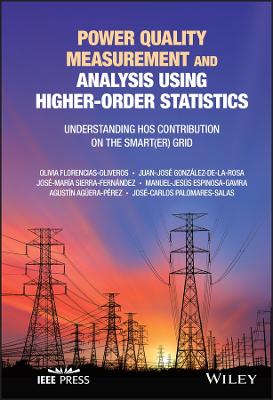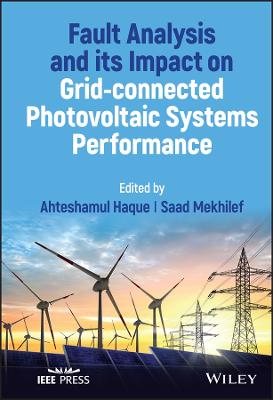Power Quality Measurement and Analysis Using Higher-Order Statistics
 -15%
portes grátis
-15%
portes grátis
Power Quality Measurement and Analysis Using Higher-Order Statistics
Understanding HOS contribution on the Smart(er) grid
Espinosa-Gavira, Manuel-Jesus; Gonzalez-de-la-Rosa, Juan-Jose; Florencias-Oliveros, Olivia; Palomares-Salas, Jose-Carlos; Sierra-Fernandez, Jose-Maria; Agueera-Perez, Agustin
John Wiley & Sons Inc
12/2022
192
Dura
Inglês
9781119747710
15 a 20 dias
Understanding HOS contribution on the Smart(er) Grid 1
POWER QUALITY MEASUREMENT AND ANALYSIS USING HIGHER-ORDER STATISTICS 3
Understanding HOS contribution on the Smart(er) Grid 3
LOGO 3
Contents 11
Contributors 14
Foreword 17
Acronyms 21
Acknowledgments 24
Chapter 1. Power quality monitoring and higher-order statistics. State of the Art 26
1.1 Introduction 27
1.2 Background on power quality 27
1.3 PQ Practices at the Industrial Level 33
1.4 A new PQ monitoring Framework 33
1.4.1 The Smart Grid 35
1.4.2 The Smart Grid and the Power Quality 35
1.4.3 Performance Indicators 36
1.4.4 Existing measurement and instrumentation solutions 37
1.4.5 New approach in Measurement and Instrumentation solutions in the SG 38
1.4.6 Economic Issues for PQ 39
1.4.7 Power Quality and Big Data 39
1.4.8 Signal Processing for PQ 40
1.4.9 HOS for PQ analysis 43
Chapter 2. HOS Measurements in the time domain 47
HOS Measurements in the time domain 48
2.1 Introduction 48
2.2 Background on power quality 48
2.3 Traditional theories of electrical time domain 49
2.4 HOS contribution in the PQ field 51
2.4.1 HOS indices definitions 51
2.4.2 HOS performance in signal processing 52
2.4.3 HOS versus electrical time domain indices 53
2.5 Regulations 55
2.6 The Sliding Window Method for HOS feature extraction 56
2.6.1 Amplitude Changes 57
2.6.2 Phase Angle Jumps 58
2.6.3 Fundamental Frequency 60
2.6.4 Waveform shape deviation 62
2.7 PQ index based on HOS 64
2.8 Representations used by the time-domain 67
Chapter 3. Event Detection Strategies based on HOS feature extraction 72
3.1 Introduction 73
3.2 Detection methods based in HOS 73
3.3 Experiment description 73
3.3.1 Computational Strategy 73
3.3.2 HOS for Sag Detection under Symmetrical and Sinusoidal Conditions 74
3.3.2 HOS for Sag Detection including Phase-Angle Jump based on Non-Symmetrical & Non-Sinusoidal conditions 75
3.3.2.1 HOS range for Transient detection including Phase-Angle Jump based on Non-Symmetrical & Non- Sinusoidal conditions 87
3.3 Flow Diagram of HOS monitoring strategy focus on detecting short duration events: detecting amplitude, symmetry, and sinusoidal states 87
3.4 Continuous event's characterization fundamental frequency 90
3.4.1 Frequency deviation regions in the HOS planes 92
3.4.2 Frequency deviation regions in the HOS planes 94
3.5 Detection of Harmonics with HOS in the time domain 95
3.6 Conclusions 97
Chapter 4. Measurements in the Frequency domain 100
4.1 Introduction 101
4.2 Frequency-domain 101
4.3 HOS in Frequency-domain 102
4.3.1 Spectral Kurtosis in Power Quality 103
4.4 Harmonic distortion 103
4.4.1 Types of Harmonic distortion 104
4.4.2 Sources of Harmonic distortion 105
4.4.3 Impact of harmonic distortion over power system 105
4.5 Traditional theories of electrical frequency-domain indicators 105
4.5.1 Harmonic measure 105
4.5.2 DFT derived measures 107
4.6 HOS contribution in PQ in the frequency-domain 107
4.6.1 Spectral Kurtosis 108
4.6.2 Spectral Kurtosis basic usage 115
4.6.3 Spectral Kurtosis and Power quality 118
Chapter 5 Measurement Campaigns and Virtual Instruments 124
5.1 Introduction 125
5.2 Virtual Instrument 126
5.2.1 Measurement Analysis Framework 126
5.2.2 Experimental Strategy for PQM through a Virtual Instrument 128
5.2.3 Configuration of the Virtual Instrument 128
5.2.4 Results 131
5.3 PQ continuous monitoring based on HOS for consumers characterization, public networks and household 132
5.3.1 Measurement and Analysis Framework 132
5.3.2 Evolution of the individual statistics histograms during several weeks 133
References 149
Annex A. Voltage Waveform 1
Theoretical power system waveform 1
Annex. B. Time-domain cumulants 1
Annex. C. HOS Range for Sag Detection, one cycle 3
Annex. D. HOS Range for Sag Detection, 10 cycles 7
Understanding HOS contribution on the Smart(er) Grid 1
POWER QUALITY MEASUREMENT AND ANALYSIS USING HIGHER-ORDER STATISTICS 3
Understanding HOS contribution on the Smart(er) Grid 3
LOGO 3
Contents 11
Contributors 14
Foreword 17
Acronyms 21
Acknowledgments 24
Chapter 1. Power quality monitoring and higher-order statistics. State of the Art 26
1.1 Introduction 27
1.2 Background on power quality 27
1.3 PQ Practices at the Industrial Level 33
1.4 A new PQ monitoring Framework 33
1.4.1 The Smart Grid 35
1.4.2 The Smart Grid and the Power Quality 35
1.4.3 Performance Indicators 36
1.4.4 Existing measurement and instrumentation solutions 37
1.4.5 New approach in Measurement and Instrumentation solutions in the SG 38
1.4.6 Economic Issues for PQ 39
1.4.7 Power Quality and Big Data 39
1.4.8 Signal Processing for PQ 40
1.4.9 HOS for PQ analysis 43
Chapter 2. HOS Measurements in the time domain 47
HOS Measurements in the time domain 48
2.1 Introduction 48
2.2 Background on power quality 48
2.3 Traditional theories of electrical time domain 49
2.4 HOS contribution in the PQ field 51
2.4.1 HOS indices definitions 51
2.4.2 HOS performance in signal processing 52
2.4.3 HOS versus electrical time domain indices 53
2.5 Regulations 55
2.6 The Sliding Window Method for HOS feature extraction 56
2.6.1 Amplitude Changes 57
2.6.2 Phase Angle Jumps 58
2.6.3 Fundamental Frequency 60
2.6.4 Waveform shape deviation 62
2.7 PQ index based on HOS 64
2.8 Representations used by the time-domain 67
Chapter 3. Event Detection Strategies based on HOS feature extraction 72
3.1 Introduction 73
3.2 Detection methods based in HOS 73
3.3 Experiment description 73
3.3.1 Computational Strategy 73
3.3.2 HOS for Sag Detection under Symmetrical and Sinusoidal Conditions 74
3.3.2 HOS for Sag Detection including Phase-Angle Jump based on Non-Symmetrical & Non-Sinusoidal conditions 75
3.3.2.1 HOS range for Transient detection including Phase-Angle Jump based on Non-Symmetrical & Non- Sinusoidal conditions 87
3.3 Flow Diagram of HOS monitoring strategy focus on detecting short duration events: detecting amplitude, symmetry, and sinusoidal states 87
3.4 Continuous event's characterization fundamental frequency 90
3.4.1 Frequency deviation regions in the HOS planes 92
3.4.2 Frequency deviation regions in the HOS planes 94
3.5 Detection of Harmonics with HOS in the time domain 95
3.6 Conclusions 97
Chapter 4. Measurements in the Frequency domain 100
4.1 Introduction 101
4.2 Frequency-domain 101
4.3 HOS in Frequency-domain 102
4.3.1 Spectral Kurtosis in Power Quality 103
4.4 Harmonic distortion 103
4.4.1 Types of Harmonic distortion 104
4.4.2 Sources of Harmonic distortion 105
4.4.3 Impact of harmonic distortion over power system 105
4.5 Traditional theories of electrical frequency-domain indicators 105
4.5.1 Harmonic measure 105
4.5.2 DFT derived measures 107
4.6 HOS contribution in PQ in the frequency-domain 107
4.6.1 Spectral Kurtosis 108
4.6.2 Spectral Kurtosis basic usage 115
4.6.3 Spectral Kurtosis and Power quality 118
Chapter 5 Measurement Campaigns and Virtual Instruments 124
5.1 Introduction 125
5.2 Virtual Instrument 126
5.2.1 Measurement Analysis Framework 126
5.2.2 Experimental Strategy for PQM through a Virtual Instrument 128
5.2.3 Configuration of the Virtual Instrument 128
5.2.4 Results 131
5.3 PQ continuous monitoring based on HOS for consumers characterization, public networks and household 132
5.3.1 Measurement and Analysis Framework 132
5.3.2 Evolution of the individual statistics histograms during several weeks 133
References 149
Annex A. Voltage Waveform 1
Theoretical power system waveform 1
Annex. B. Time-domain cumulants 1
Annex. C. HOS Range for Sag Detection, one cycle 3
Annex. D. HOS Range for Sag Detection, 10 cycles 7







